Fun on the obstacle course!
By Michele Welton, Dog Trainer, Breed Selection Consultant, Author of 15 Dog Books
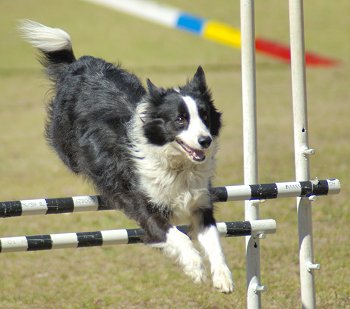 In the sport of dog agility, which you may have seen on TV or on YouTube, dogs run through an obstacle course – jumping hurdles, dashing through tunnels, and traversing balance beams.
In the sport of dog agility, which you may have seen on TV or on YouTube, dogs run through an obstacle course – jumping hurdles, dashing through tunnels, and traversing balance beams.
Dog agility is not only great fun, but also provides a constructive physical outlet for your pup's energy. Mastering agility obstacles improves his coordination and self-confidence, as well.
You can play such a game in your own backyard (on GRASS or DIRT, not on concrete), or even in a large indoor game room (on CARPET, not wood, vinyl, or tile).
You can buy obstacles online from affordableagility.com (still expensive, just less so than most other commercial sources). Or if you're handy, you can make a few simple obstacles yourself. Just make sure they're very sturdy!
If you assure your pup that something is safe, and he falls off it, or it collapses, he will lose faith in you and may never want to try anything new again. So build sturdy or else buy commercial!
"Jump" or "Over!"
 A jump can be a solid hurdle or a bar jump (two vertical posts supporting a horizontal bar). You can construct a bar jump using plastic PVC pipe, which is lightweight and inexpensive.
A jump can be a solid hurdle or a bar jump (two vertical posts supporting a horizontal bar). You can construct a bar jump using plastic PVC pipe, which is lightweight and inexpensive.
To make it easier for your pup to see, wrap strips of colored contact paper around the white pipe at spaced intervals. Or use paint.
Very important: keep jumps set low!
Don't set the height of a jump based on how high your dog can jump – but rather on how high he should jump.
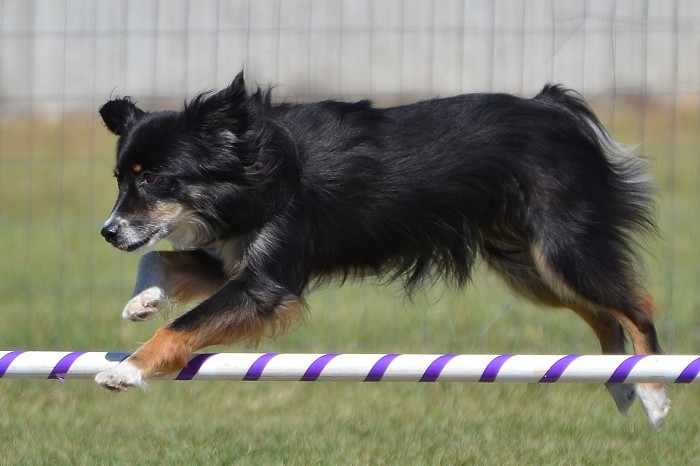
The legs of puppies and adolescent dogs have growth plates that expand as the pup grows. While those growth plates are still expanding, a pup's bones and joints are very fragile. Jumping too high or too often can severely damage them, sometimes irreparably.
It's the impact of landing that causes the most stress on bones and joints.
When do the growth plates close permanently? If your pup will mature at less than 50 pounds, his growth plates should close at 10 to 12 months old. If he will mature at over 50 pounds, his growth plates typically close at 12 to 14 months old.
Until their growth plates have closed, a pup should only jump his height at the elbow or 12 inches – whichever number is LESS. The elbow is the bony protuberance on the backside of his front leg, just below where the leg attaches to the body.
Once his growth plates have closed, jump height can be increased to the top of his shoulder blades. No dog should jump higher than their shoulder blades on a regular basis.
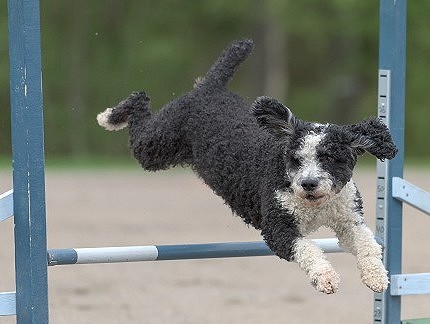
Spanish Water Dog clearing a bar jump.
Secure footing on both sides of the jump is essential. Dogs are injured during take-offs and landings when they slip on a slick surface or come down hard on a surface that's rigid and unforgiving.
So.... YES to dirt, soft grass, rubber matting, or carpeting. NO to bare wood, vinyl, tile, concrete, stone, or sharp prickly grass.
To teach your dog to jump:
- Place two or three jumps about ten feet apart. Set each jump no more than the height of the dog's elbow, or 12 inches – whichever number is LESS.
- With your dog on leash, walk over the series of jumps with him. As you reach each jump, say, "Jump!" or "Over!"
- Reward with a treat when you've cleared the last jump. Soon you can increase your speed to a trot. Finally, trot toward the jump with him, but at the last second, you should veer around the side of the jump while he goes over himself.
A mistake made by impatient owners is to take their dog off-leash too soon! An off-leash dog can easily veer around the jump and once this bad habit has been introduced to his brain, it can be difficult to change. So be patient. Keep your dog on-leash until his brain has formed the rock-solid pattern that "Jump" always means OVER – never around.
"Go Tunnel!"
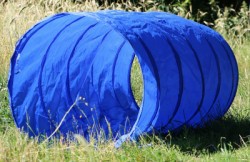 You can buy a children's play tunnel made of vinyl (kind of flimsy) or nylon (better quality) from a local toy store or on Amazon. Or you can buy a more durable tunnel from affordableagility.com
You can buy a children's play tunnel made of vinyl (kind of flimsy) or nylon (better quality) from a local toy store or on Amazon. Or you can buy a more durable tunnel from affordableagility.com
You can also make a short homemade tunnel out of large boxes, or a trash can with the bottom cut out. At first, use a short straight tunnel so the dog can see through to the other side.
Brace the tunnel securely along both sides so it can't roll while your pup is inside, which could spook him.
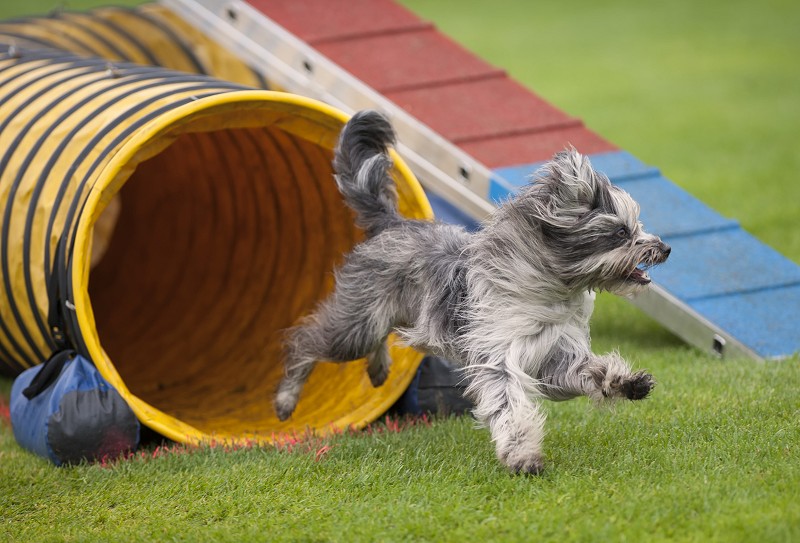
Pyrenean Shepherd racing through the tunnel. See the heavy sandbag weights securing the tunnel so it can't roll. Most dogs come to LOVE tunnels!
To teach your dog to go through tunnels:
- Have a helper hold your dog by the collar at one end of the tunnel while you crouch at the opposite end.
- Stick your head inside and call, "Jake, here I am, Jake!" Wave a treat inside the tunnel to get his attention. You want him to peer in and make eye contact with you so you can encourage him to come through.
- Once he's all the way into the tunnel, your helper should make sure the dog doesn't suddenly change his mind and try to back out the same way he went in. This is common for beginner dogs who lose their nerve halfway through!
So once he's in, whatever you have to do, try hard to make sure he comes out the other side. When he reaches you, he gets praise and a treat!
When your dog is confident about a straight tunnel, curve it into a "U" shape. This can be psychologically difficult for some dogs because they can't see any light at the other end. They have to enter the dark end and trust that there will be an exit.
Finally, if the tunnel is long enough, you can curve it into an "S" shape.
"Go Table!"
![]() This obstacle is a 3-foot by 3-foot platform set on four sturdy legs 8 to 24 inches high, depending on your dog's size. Make sure the table is covered with securely-fastened, non-slip carpeting or rubber matting.
This obstacle is a 3-foot by 3-foot platform set on four sturdy legs 8 to 24 inches high, depending on your dog's size. Make sure the table is covered with securely-fastened, non-slip carpeting or rubber matting.
You tell your dog "Go table!" and he must jump onto it and remain there for 5 seconds, then you send him on to the next obstacle.
This obstacle will be a snap for your dog if you've already taught him "Go place!"
Never reward your dog for jumping OFF the table. If he jumps off before you reach him, say "Ah-Ah. Go table!" Only give him his treat ON the table, so he learns to get up there and stay put.
"Walk it!" (balance beam)
![]() In agility competition, it's called a dogwalk. It's a wide balance beam with a ramp at each end. The dog trots up one ramp, trots along the central plank, and trots down the other ramp.
In agility competition, it's called a dogwalk. It's a wide balance beam with a ramp at each end. The dog trots up one ramp, trots along the central plank, and trots down the other ramp.
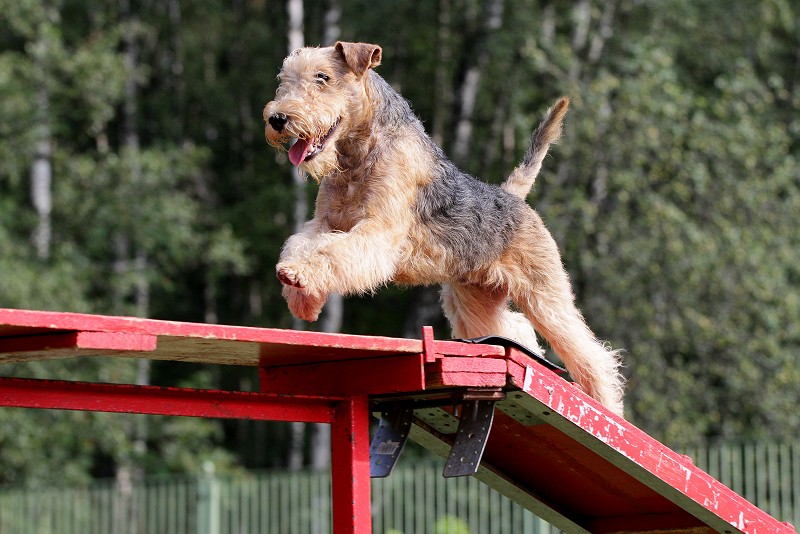
You can make a partial dogwalk with just the central plank (no ramps) by taking a board (at least a foot wide, and 4-8 feet long) and raising it off the ground a few inches with concrete blocks.
You can also add ramps, as long as they're not too steep and as long as you prop them securely (or better yet, attach them to the central plank) so they can't fall. If a ramp suddenly plunks to the ground while your pup is walking on it, it might be too low to hurt him physically.... but psychologically, it could be very bad and he might never walk on it again.
Remember.... safety, safety, safety. Build obstacles sturdy. Keep obstacles low. Keep your pup's leash on when he's learning. Accidents and fearful experiences can have long-lasting consequences.
Use treats to lure your pup across the dogwalk, going nice and slow. Some dogs are more adventurous, while others are more cautious. In general, small and medium-size breeds have better coordination than larger breeds.
 See the yellow painted area? That's called a contact zone and your dog is supposed to touch it on the UP incline AND on the DOWN incline as well. This is to prevent him from the dangerous habit of taking those ramps too fast and even jumping off them.
See the yellow painted area? That's called a contact zone and your dog is supposed to touch it on the UP incline AND on the DOWN incline as well. This is to prevent him from the dangerous habit of taking those ramps too fast and even jumping off them.
Hence the yellow paint, as a reminder to TEACH your pup that for his own safety, he must touch the bottom of the ramps.

Building confidence with different surfaces
It can be amusing to watch a dog's reactions when he encounters a type of footing that he has never traversed before. Some pups aren't fazed by anything, whereas others totally balk.
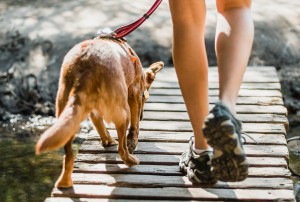 Just as it's good for US to learn new skills and try new things, it's good for dogs, too. The more things you expose them to, the more comfortable they are in the world that we all share.
Just as it's good for US to learn new skills and try new things, it's good for dogs, too. The more things you expose them to, the more comfortable they are in the world that we all share.
So think of things that your dog hasn't encountered yet. For example, different types of surfaces that he might one day need to walk across.
You might lay down:
- plastic sheeting or a crinkly tarp
- ceramic tiles
- soft sand
- a metallic surface of some kind
- a layer of crinkly leaves
- a shallow pool of water
- low platforms for your pup to hop on and off
As you walk him around your obstacle course, on leash at first, coax him over the different surfaces. Remember, this is a GAME. Use treats liberally, and no corrections!
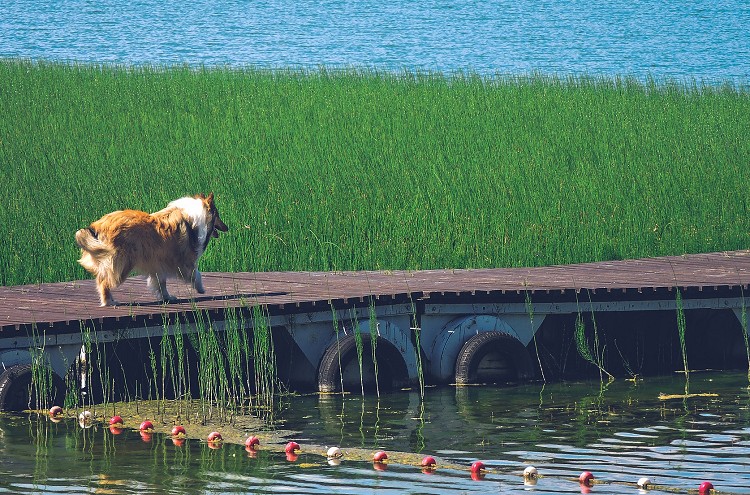
My best-selling books – now available FREE on my website
 Respect Training For Puppies: 30 seconds to a calm, polite, well-behaved puppy is for puppies 2 to 18 months old. Your puppy will learn the 21 skills that all family dogs need to know. Click here to read for free.
Respect Training For Puppies: 30 seconds to a calm, polite, well-behaved puppy is for puppies 2 to 18 months old. Your puppy will learn the 21 skills that all family dogs need to know. Click here to read for free. Teach Your Dog 100 English Words is a unique Vocabulary and Respect Training Program that will teach your adult dog to listen to you and do what you say. Click here to read for free.
Teach Your Dog 100 English Words is a unique Vocabulary and Respect Training Program that will teach your adult dog to listen to you and do what you say. Click here to read for free. 11 Things You Must Do Right To Keep Your Dog Healthy and Happy helps your dog live a longer, healthier life. Get my honest advice about all 11 Things before you bring home your new puppy, because some mistakes with early health care cannot be undone. Click here to read for free.
11 Things You Must Do Right To Keep Your Dog Healthy and Happy helps your dog live a longer, healthier life. Get my honest advice about all 11 Things before you bring home your new puppy, because some mistakes with early health care cannot be undone. Click here to read for free.
